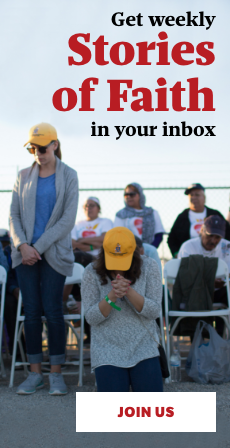A couple of days after a direct hit from Hurricane Maria had devastated much of the northern Puerto Rican town of Vega Baja and after the floodwaters had receded enough, Father Jorge Morales, the pastor of Our Lady of the Rosary Parish, and some of his parishioners were finally able to reach their historic church. The storm had ripped open the heavy doors, flooded the church, torn off the roof and smashed the windows. It had been left in ruin and was unusable.
“We were heartbroken,” said Miguel Ríos, one of the parishioners. “This church is like a second home to us.”
But Father Morales told them:
The church building is secondary. The important thing is to take care of our neighbors. They need us now.”
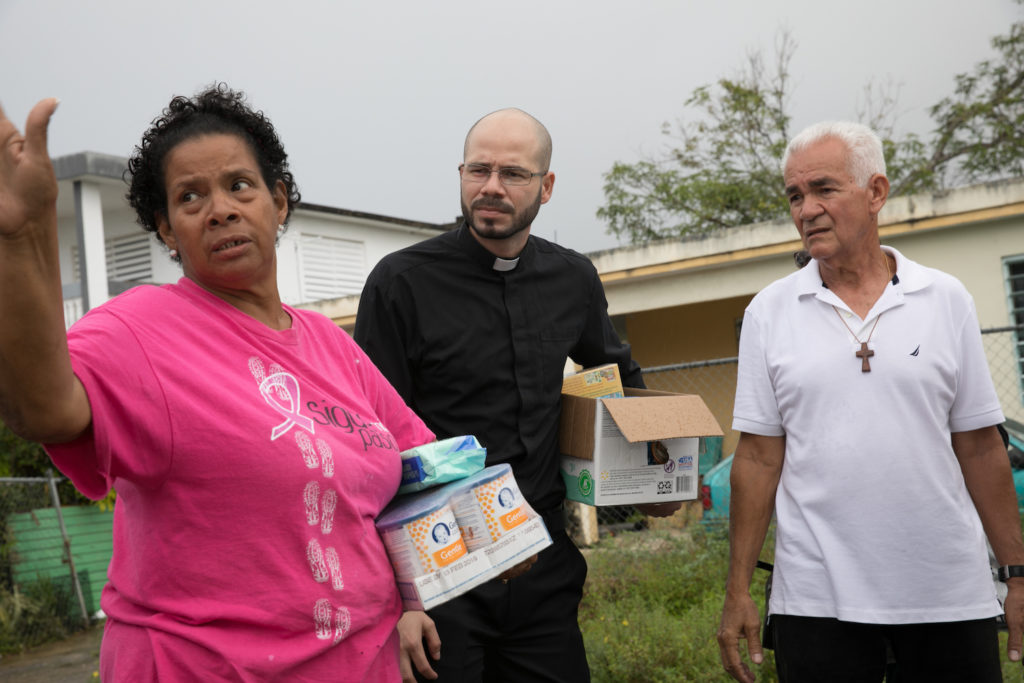
For the next few months, Father Morales and the parishioners devoted themselves to assisting the families most affected. They were the first to reach and bring food to the hardest-hit neighborhoods, where many people had lost everything. They organized a coordinated effort to deliver food, water, supplies and hope to the people.
For six weeks, they prepared and delivered about 200 warm meals each day.
“It was incredible,” Father Morales remembers.
I never asked for a single dollar of donations to buy the food. But somehow every day people who had very little themselves gave us some of their money or brought food that we could cook.”
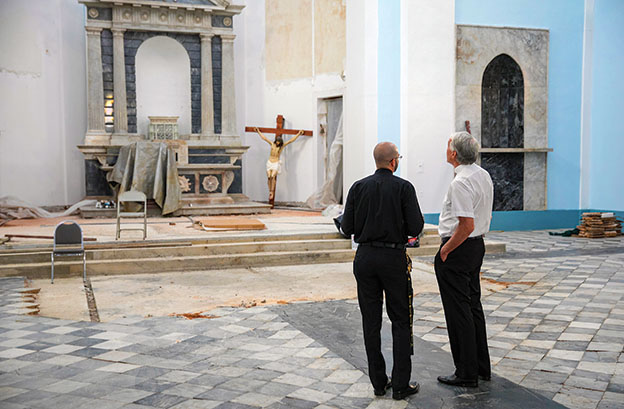
Father Morales said he was struck by the great sense of generosity in such an extreme crisis. His parishioners are working-class and poor people, and even some who had lost much themselves would reach out to those who had it even worse, counting themselves “bendito,” blessed.
The aftermath of the hurricane, Father Morales said, “has been an opportunity for us to rediscover our Christian vocation, which is to go out and reach out to those in need and to proclaim the good news with our witness of service and practice of charity and solidarity.”
That work continues today. Lissette Díaz, one of the parish’s most dedicated volunteers, hasn’t stopped moving since the second day after the hurricane. “It has been a unique and wonderful experience,” she said. “I give thanks to God for our parish community.” She added with a laugh that she has lost 12 pounds from running around to help people.
For the past six months, the parish has been celebrating Mass in a crammed room of the parish center, where buckets are set up to catch the water dripping from the ceiling.
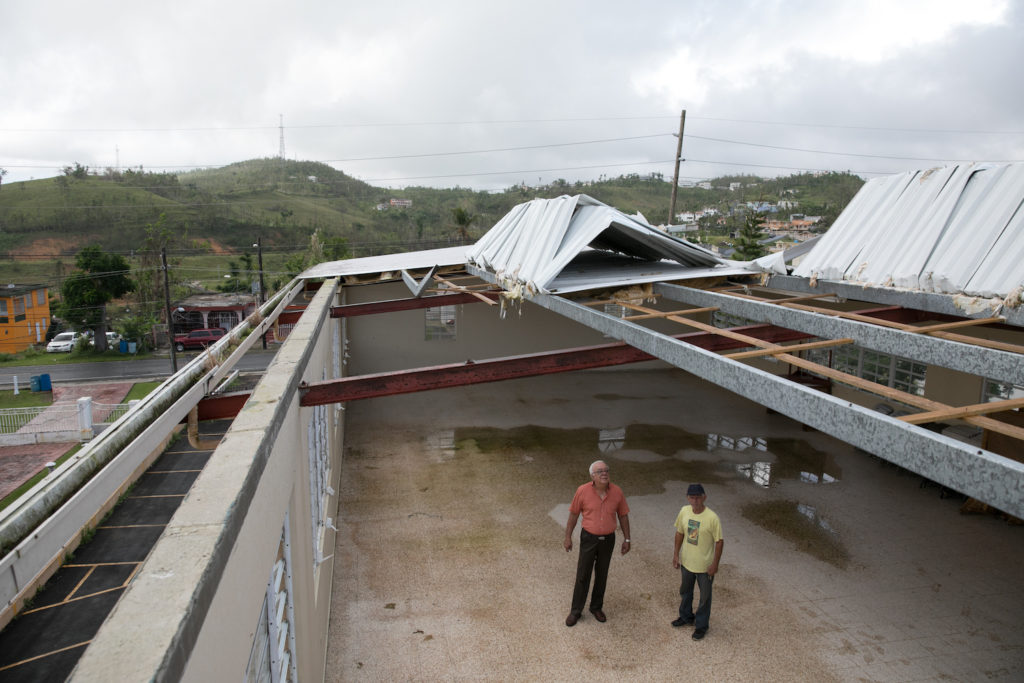
Even before Maria, Catholic Extension Society was no stranger to this parish and its pastor, providing construction grants and supporting the pastor’s seminary education. Over the years it has funded building projects for all four Vega Baja parishes, and it continues to support the education of Puerto Rico’s priests.
The Crucial Role of Faith Communities
“In moments of great difficulty and challenge, you can see the power of faith communities alive in people’s hearts and lives,” said Father Jack Wall, president of Catholic Extension Society, during a visit to Puerto Rico in early March.
People come together in faith in moments of crisis to strengthen one another and to realize that they are not alone. As faith communities, we embody the spirit of God. We are one together.”
The crucial role that faith communities have played in delivering help, hope and healing to people has underscored their vital importance for the communities they serve, particularly in remote and isolated areas.
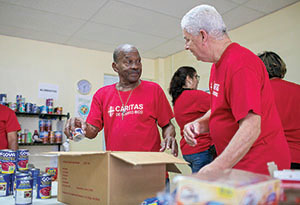
To a great extent, the exemplary outreach of the Puerto Rican churches is also a result of and testament to the 110 years of Catholic Extension Society building churches on the island.
Working with the six dioceses of Puerto Rico, Catholic Extension Society has provided support for church construction, leadership development and ministry.
Since its first church-building assistance to the Archdiocese of San Juan in 1908, Catholic Extension Society has supported 1,400 construction and repair projects of church buildings in Puerto Rico. There are few churches on the island that Catholic Extension Society hasn’t helped at some point in time.
As recounted in news reports, government and relief agencies failed to reach many of the more isolated and impoverished areas for weeks. In some places, residents note that without the churches springing into action, relief efforts would have been totally stymied.
Without churches, many helpless, elderly community members stranded in destroyed or damaged homes would not have been sought out and cared for. Without churches, many of the hundreds of thousands of meals that were so desperately needed in the first few weeks would not have been prepared and distributed. Without churches, many people would not have been able to access lifesaving medical services they needed. Without churches, many would feel alone, abandoned and desperate.
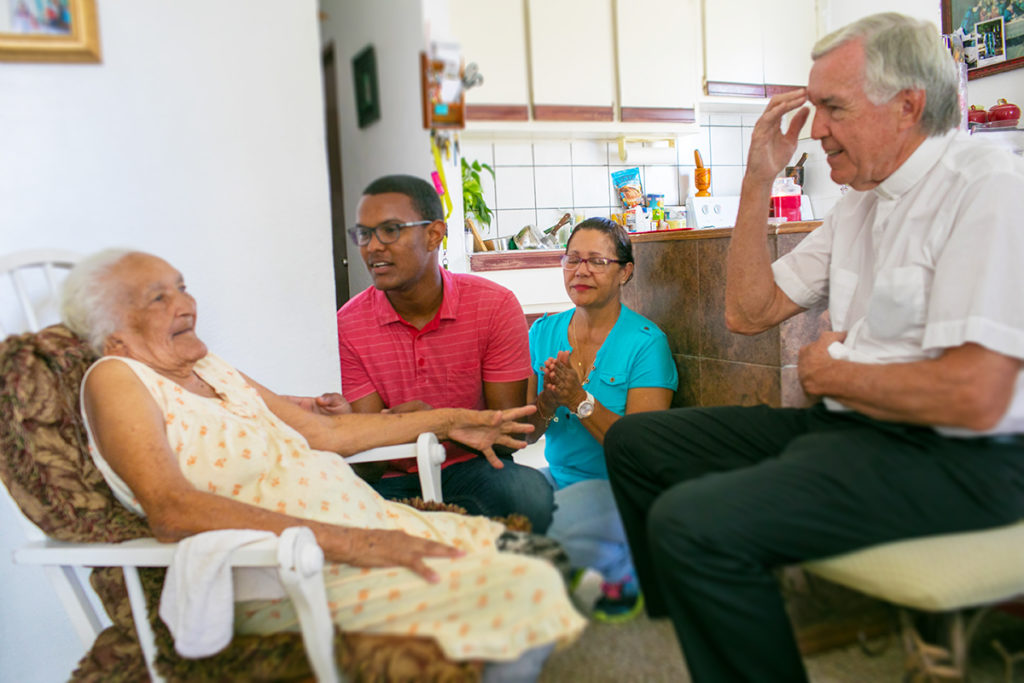
With churches, people instead have found the strength to carry on in the face of overwhelming difficulties and mental stresses, which are continuing today. Churches serve all in need, and, according to Father Morales, many non-Catholics have expressed their gratitude for that. “They have told us, ‘How good that we have felt the Church so close, that you have come when we needed you most.’”
As The Wall Street Journal noted in November, “The island’s Christians are clearly playing a central role in the recovery. … Although many church buildings have been damaged, the churches that remain are a haven for those in need.” In fact, even those church communities whose buildings were damaged found ways to carry out amazing works of mercy, lifting up the communities around them.
True Miracles
Our Lady of the Rosary is not an isolated example of a church heroically serving its community after the hurricane. Churches all across the island have risen to the occasion.
In December, when Pope Francis sent Catholic Extension Society’s chancellor, Cardinal Blase Cupich, to make a pastoral visit to Puerto Rico on his behalf, one of the parishes he visited was Our Lady of Mount Carmel in Punta Santiago in the Diocese of Fajardo-Humacao. Catholic Extension Society helped to build the church and its parish building in 1987.
Hurricane Maria first made landfall in Puerto Rico in this fishing village, flattening the community with winds topping 155 miles an hour. According to Father José Colón, the pastor, flooding from a storm surge of eight feet came from all directions. An estimated 90 percent of residents lost their homes and belongings.
Although the floods dragged the church pews out into the streets, the church itself was one of the few buildings left standing, and its statues and altar suffered no damage.
People called it a miracle, Father Colón told the Brooklyn Tablet, “but I say the true miracle has been this religious experience, this encounter with Christ that we have seen after the hurricane. People are more united, more like brothers and sisters, and we give each other a hand and pull together ahead.”
During Cardinal Cupich’s visit, Father Colón passionately described the ways in which his small Catholic mission had helped the community after the storm: feeding people, providing clothes as well as medicines, medical and mental-health services and helping clean the homes of the elderly.
As he concluded, he implored the cardinal, “Tell the pope that we have seen the fruits of giving of ourselves and that the Lord has blessed us with the cross, but through it all we have experienced the balm of His mercy.”
Catholic Extension Society’s Role
Since last September, Catholic Extension Society has provided and committed more than $1.1 million in support of the Church in Puerto Rico. Donors have very generously responded to Catholic Extension Society’s fundraising appeals to help all the mission dioceses devastated by last year’s hurricanes — the six dioceses of Puerto Rico, the Diocese of St. Thomas in the U.S. Virgin Islands and the Diocese of Beaumont, Texas.
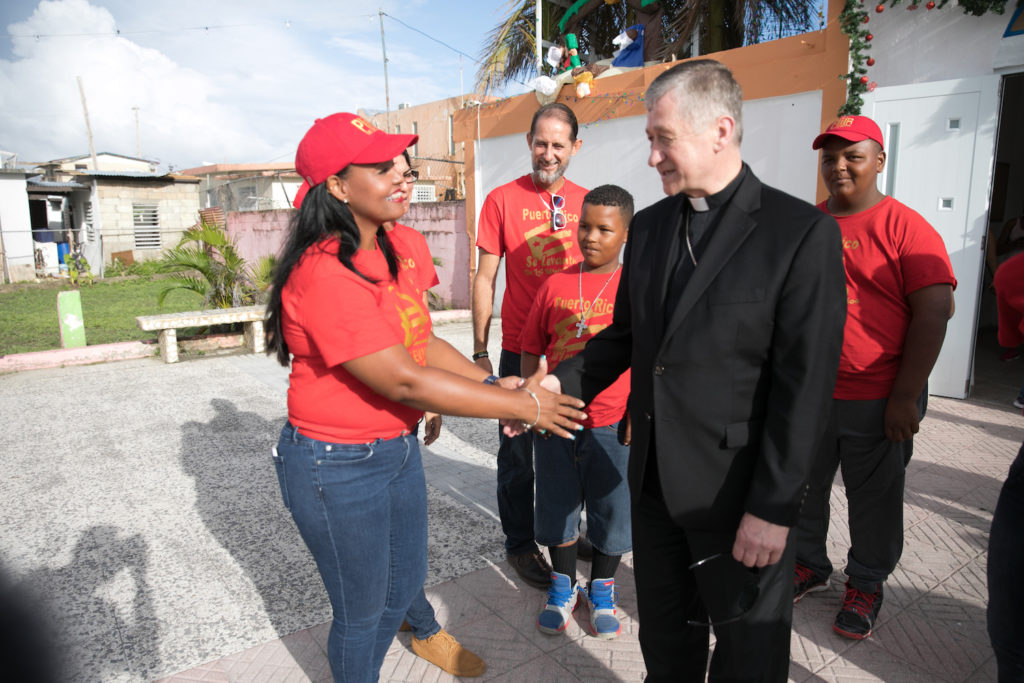
In addition to extending emergency funding immediately after the hurricanes, Catholic Extension Society has been supporting poor parishes and their ongoing ministries and services to their communities.
Even after six months, the pain caused by Hurricane Maria is still on full display. Once-bustling town centers and business districts are shuttered in cities large and small, signaling a massive loss of incomes and livelihoods. Collapsed buildings, flooded homes and tarp-covered, roofless structures abound.
It has taken excruciatingly long to restore power and running water to much of the island. Even at the six-month point, 7 percent of homes — some 121,000 residents — have not yet received power.
Not only did Hurricanes Maria and Irma devastate many of the island’s homes, buildings and infrastructures, but the blow to the already struggling Puerto Rican economy has also led to many Puerto Ricans losing their jobs and livelihoods and has increased poverty on the island. Puerto Rico’s poverty rate is now at an astonishing 52.7 percent. Children continue to be the most vulnerable, and in some mountain areas, child poverty rates exceed 80 percent.
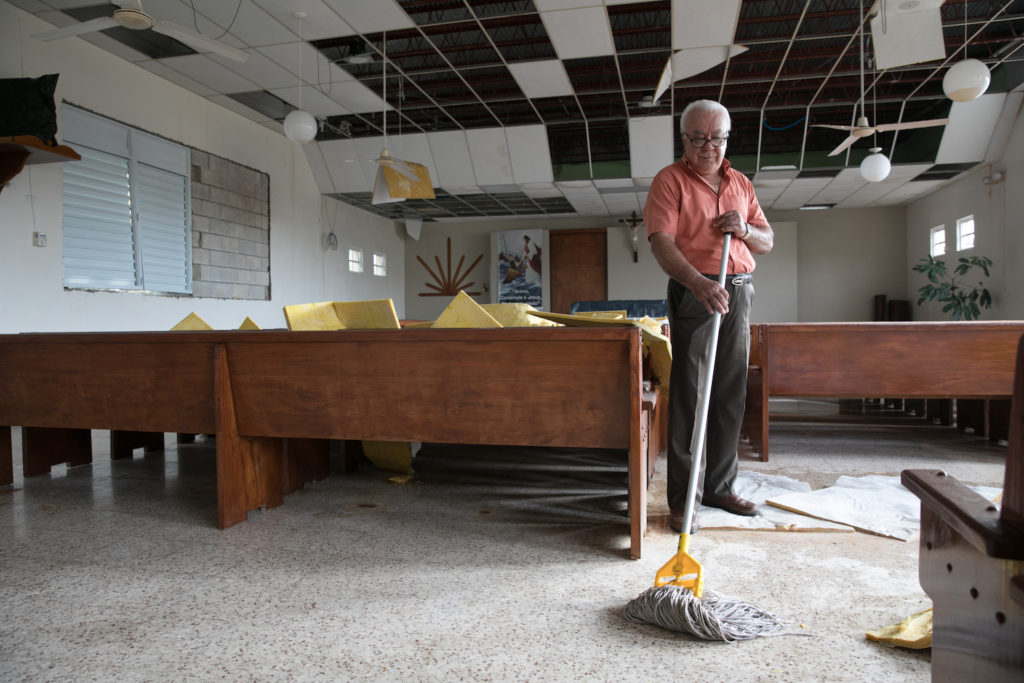
These economic realities have also greatly diminished Puerto Rican parishes’ own financial resources. Their faith and mission are strong, but their needs are great and will require support for years to come.
Just prior to the hurricanes, Archbishop Roberto González of San Juan, Puerto Rico, invoked the protection and intercession of the patroness of Puerto Rico, Our Lady of Divine Providence, and assured the people that “a united Puerto Rico is stronger than any hurricane that tries to break our spirit and bend our wills.”
He still exudes that firm belief that God’s providence will provide, even after struggling through the exhausting months of rescue and relief operations. “I feel very confident about the future,” he said, “because I have seen how our people have come together after the hurricane.” Perhaps a sign on the front gate of the heavily damaged St. Martin de Porres Chapel in Cidra says it best. The sign advertises Mass times at nearby churches. At the bottom, someone has written, “With God, Puerto Rico rises.”
